Offering Two-Day Training Content
If you are teaching the Situation Monitoring Module as part of a two-day training, you should be able to perform all the activities noted below in around 60 minutes. Components to use in this section include:
Introductory Teamwork Exercise #2: 8 minutes
Objectives and Introduction to Situation Monitoring: 5 minutes
Situation Monitoring: 4 minutes
- The concept: 2 minutes
- Group discussion: 5 minutes
- What they are and why they matter: 4 minutes
- Overcoming challenges to them: 6 minutes
- Overview of tools: 1 minute
- STEP: 6 minutes
- I'M SAFE: 4 minutes
- Cross-monitoring
- The concept: 2 minutes
- Video discussion: 7 minutes
- STAR: 5 minutes
Unit Summary: 3 minutes
Additional examples and insights for the situation monitoring content are included in section 2 above. Trainers should review the entire contents of section 2 so they can use examples and share insights that are most relevant to groups they are teaching.
Teaching Goals
It's important to continuously reinforce your enthusiasm for TeamSTEPPS and its importance to patients and healthcare workers. You also should continue to foster mutual respect, fun, and transparency through the use of active learning and listening throughout the section. Specific goals for teaching this section include some related to an understanding of situation monitoring concepts and others related to the situation monitoring tools. Objectives for this module are identified below.
- Understand how situation monitoring affects team processes and outcomes.
- Explain situation awareness and identify approaches to maximize it.
- Define a shared mental model and how it is cultivated within a team.
- List components of the STEP and other mnemonic tools.
Teaching Process
Introductory Teamwork Exercise #2
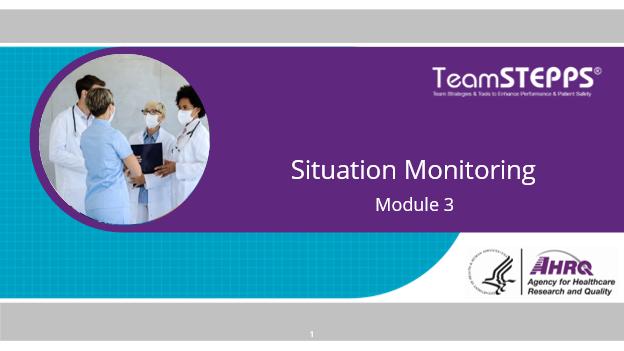
In Slide 1, “Situation Monitoring,” welcome the participants to the start of Module 3, which focuses on situation monitoring. Explain that teaching about situation monitoring needs to start with a discussion of what it is and why it matters, followed by teaching specific tools that can be used to improve this skill. Note that situation monitoring builds on the communication skills discussed in Module 1 as well as the team leadership tools taught in Module 2.
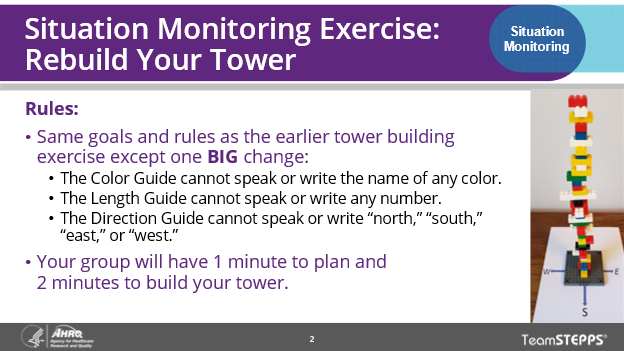
Using Slide 2, “Situation Monitoring Exercise,” explain that Module 3 will start with a return to the exercise they participated in at the beginning of the course. Refer to the exercise instructions document for more details.
Explain the key rule change they’ll need to follow for this exercise. Then dismiss the groups to their breakout areas and have the Facilitators lead the exercise. Once the exercise is complete, have the class return for the exercise discussion.
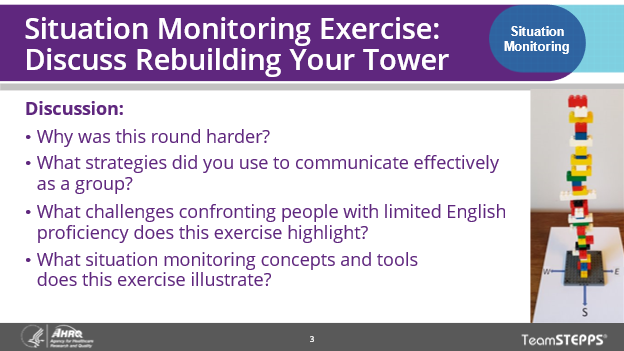
When the class has returned, use Slide 3, “Situation Monitoring Exercise: Discuss Rebuilding Your Tower” to discuss the questions noted on the slide. Use the discussion to emphasize the importance of teamwork in helping to create shared understandings of processes and methods for communicating.
Objectives
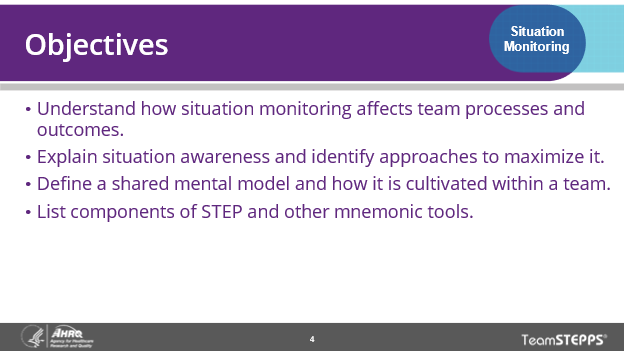
Referring to Slide 4, “Objectives,” review the objectives for the Situation Monitoring Module; save time by displaying the slide without orally reviewing each objective. Stress the broad goal of acquiring insights and tools that will enable the participants to function more effectively in teams that include patients and family caregivers. Objectives include:
- Understand how situation monitoring affects team processes and outcomes.
- Explain situation awareness and identify approaches to maximize it.
- Define a shared mental model and how it is cultivated within a team.
- List components of the STEP and other mnemonic tools.
Situation Monitoring
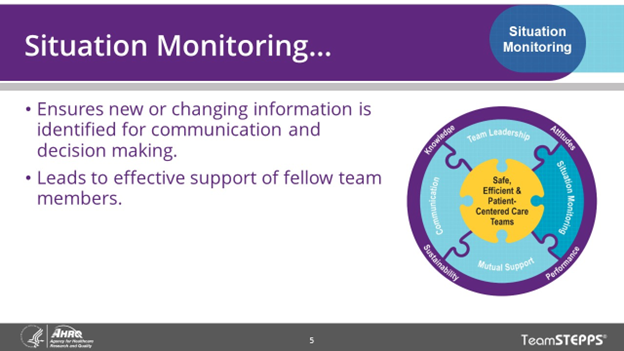
Review Slide 5, “Situation Monitoring,” which includes the TeamSTEPPS graphic, and remind your class that all four key skills, including situation monitoring, support each other and are designed to mutually contribute to safe, efficient, happy, and patient-centered care teams.
Explain that situation monitoring is a way for team members to be aware of what is taking place around them. That awareness will allow them to adapt to changes in the situation and create opportunities to support other team members when needed. Note that situation monitoring is achieved through communication and should be reinforced by team leaders. It also allows mutual support through the ability to anticipate other team members’ needs with accurate knowledge of their responsibilities.
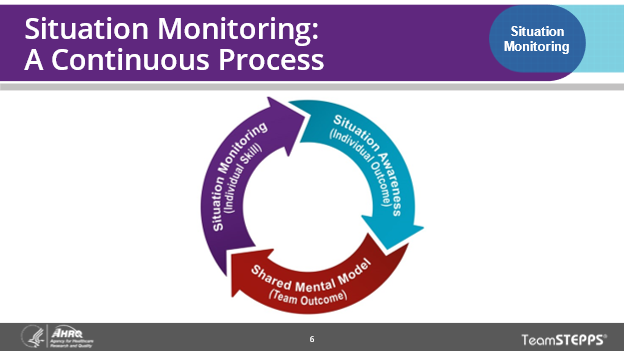
As you introduce Slide 6, “Situation Monitoring: A Continuous Process,” ask participants to think about how often over the course of a single workday important changes happen to their patients, patient care plans, teams, or working environment. Give them options of none, fewer than 5 times a day, 6-10 times a day, 11-20 times a day, or even more. Use the question responses to make the point that situation monitoring needs to be continuous because the situation is fluid.
Briefly introduce the three concepts of situation monitoring, situation awareness, and the shared mental model, and explain that having the skill of situation monitoring helps each team member maintain situation awareness. When the teams communicate effectively about what they are aware of, the end result is a shared mental model.
Situation Awareness
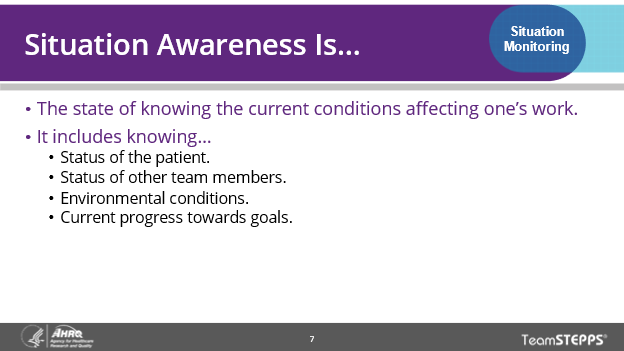
Use Slide 7, “Situation Awareness Is,” to develop the concept of situation awareness. Note what situation awareness is and that it includes the four components noted on the slide. Ask one or two participants to share a recent experience where they were unaware of one or more of these components and how it made their job more challenging. If participants are from different care settings, include multiple settings to make the point that situation awareness matters everywhere—not just in the hospital. Note that STEP as a tool will be discussed again along with the other situation monitoring tools.
Next, introduce situation awareness as the outcome that results from continuous situation monitoring. Remind them that situation monitoring is the SKILL that leads to the OUTCOME of situation awareness. Then have them break up into small groups for a short discussion.
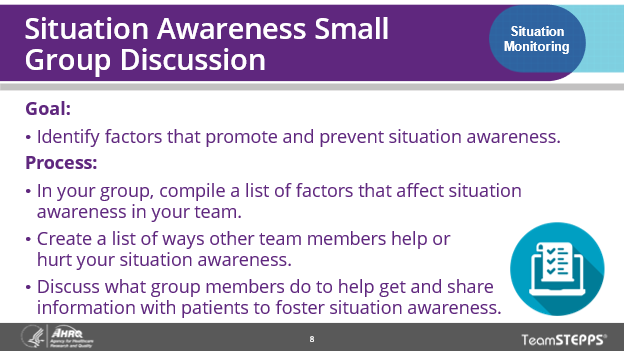
While Slide 8, “Situation Awareness Small Group Discussion,” is displayed, give the teams 5 minutes to address the three process discussion questions identified on the slide. Encourage each group to have at least one idea from each member of their group. After 5 minutes, reconvene the teams.
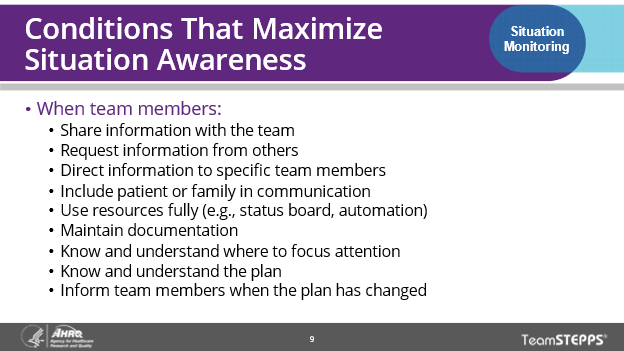
Using Slide 9, “Conditions That Maximize Situation Awareness,” ask the groups to compare their lists of factors affecting situation awareness with the ones on the slide. Have groups identify any additional conditions that aren’t mentioned on the slide and use these to reinforce the fact that many things affect situation awareness, which makes it challenging to sustain.
Shared Mental Models
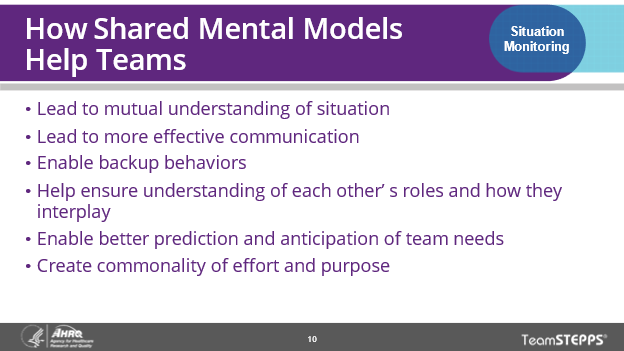
Slide 10, “How Shared Mental Models Help Teams,” can be used to introduce the concept of a shared mental model as a team outcome that is vital to providing safe and effective patient care and to satisfying and efficient team functioning. Then briefly call attention to two or three bullet points that seem most relevant to your class.
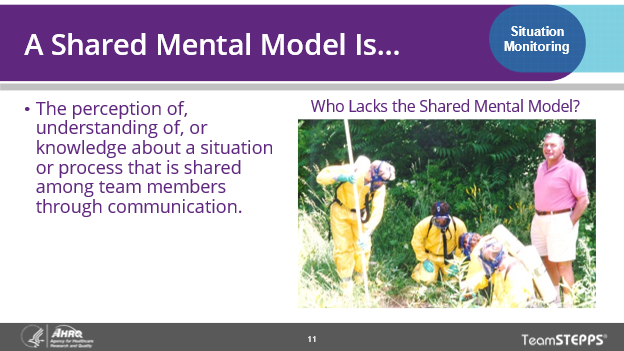
Move to Slide 11, “A Shared Mental Model is,” and give participants a chance to react to the picture. Then note what a shared mental model is using the definition on the slide. Key points to make include:
- That shared mental models are TEAM outcomes that occur when team members communicate effectively with each other.
- That shared mental models are always at risk as the situation awareness of team members changes.
- That differences in perspectives and priorities between team members can cause the same information to be processed very differently.
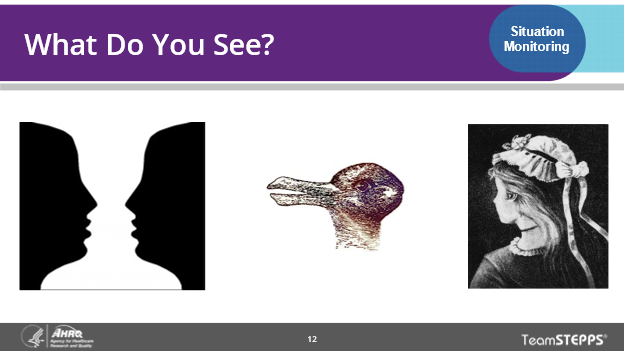
As you display Slide 12, “What Do You See?” ask participants what they see in each of the three figures. The options include: two people or a vase, a duck or a rabbit, and a young woman or an older woman. Then ask them to share an example of a time when two people on their team had the same information but interpreted it very differently. As a followup question, ask why they think the interpretations were different and what they did to try to reconcile them to foster a shared mental model.
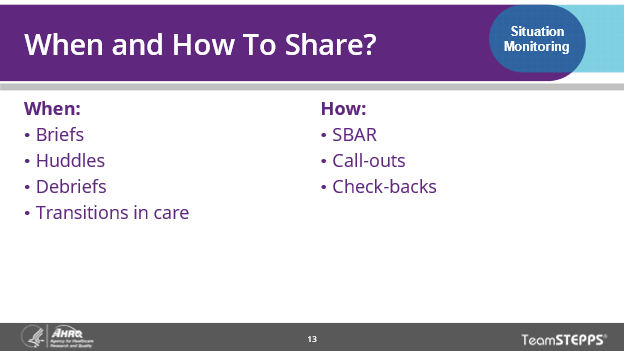
Using Slide 13, “When and How To Share?” note that effective teams need to be working continuously to retain shared mental models and that communication needed to sustain shared mental models can occur in specific meetings such as those listed on the slide or in informal conversations between team members, including the patient. Then remind them of specific communication tools that can help share key information effectively.
Situation Monitoring Tools
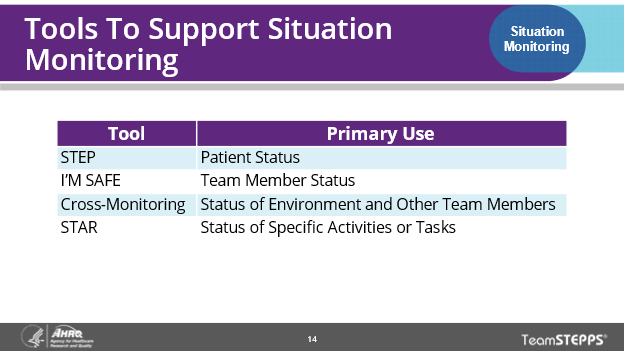
Slide 14, “Tools To Support Situation Monitoring,” allows you to explain to participants that they’re now going to learn about four situation monitoring tools used to foster a shared mental model. Note that other tools are available, including one specifically for use in diagnosis, discussed in the TeamSTEPPS for Diagnosis Improvement course.

Slide 15, “Status of Patient,” is where you will introduce STEP as a foundational situation monitoring tool that focuses attention on four key elements affecting patient care, beginning with the patient. In your discussion of the patient, you may want to ask participants which of the elements noted in the box is most often overlooked by their teams and why. You may particularly want to call attention to the issue of limited English proficiency, which is often unrecognized and places patients at greater risk of harm.
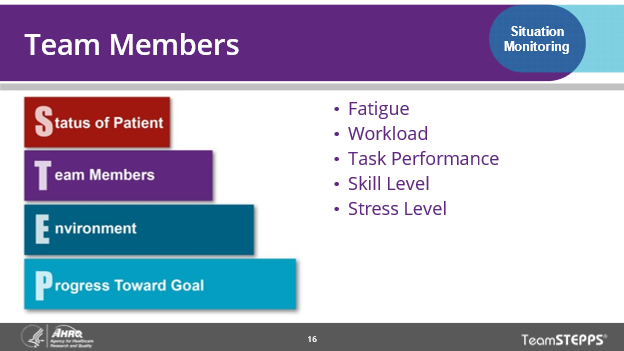
Slide 16, “Team Members,” transitions the discussion of STEP to information about the team. Acknowledge that everyone has times when they are experiencing one or more of the challenges noted in the box and note that they’ll soon learn about a tool called I’m SAFE that can help monitor themselves and other team members.
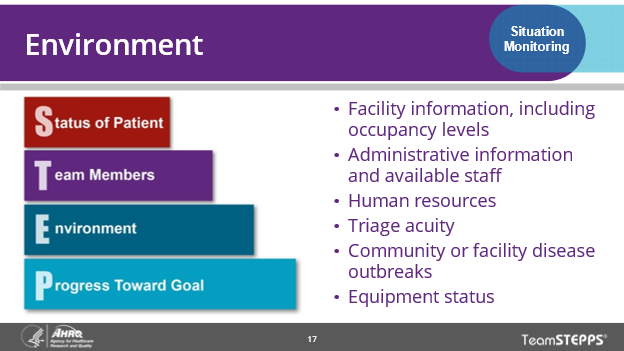
Using Slide 17, “Environment,” ask participants to look at this list and identify other environmental factors that are important to consider in their work environment. Use their responses to make the point that every working environment poses threats the team needs to monitor.
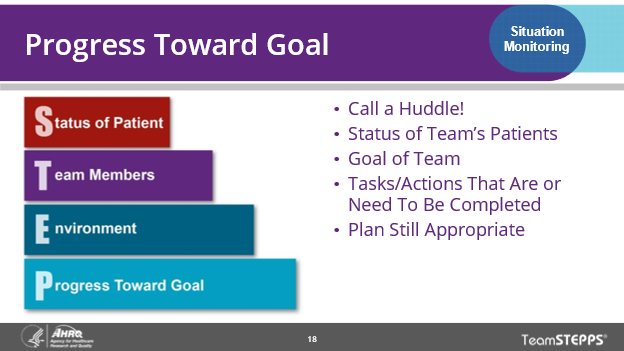
Slide 18, “Progress Toward Goal,” allows you to note that care and patient care plans always involve goals team members should be monitoring. If time permits, have participants share common goals for patients they care for.
Once the overview of STEP is complete, note that the next tool is an important way to ensure patient safety and a positive working environment. Then introduce Slide 19, “Tools for Situation Monitoring: I’M SAFE Checklist.”
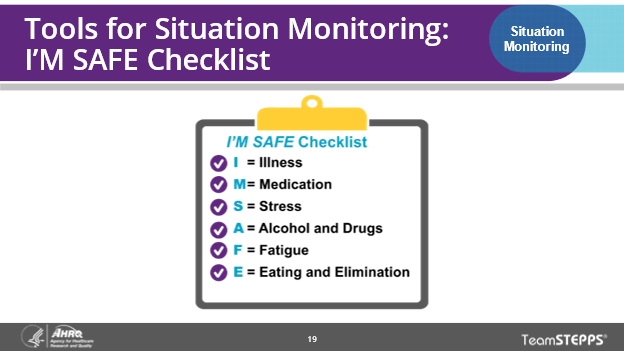
On Slide 19, “Tools for Situation Monitoring: I’M SAFE Checklist,” note that each item on the checklist has a direct, proven link to patient safety and that all these issues affect some of the staff in any organization almost every single day. Explain that encouraging people to acknowledge when one or more of these factors (e.g., illness, medications, stress) may be affecting them requires a nonpunitive culture where the response to disclosure will be support and not punishment. Note that the goal is not to decide whether each team member is or isn’t safe. It’s to understand any issues that might affect safety and to help the team compensate or respond in a way that supports the team member and protects the patients.
Ask participants to share a time when a team member was struggling and the team intervened to support the individual to ensure safe, quality patient care. A participant might then share how they’d offered to help a coworker catch up on paperwork they were behind on (compensation) or volunteered to cover for a peer who needed time to eat—something they’d been unable to do for over 7 hours (response). If you keep the focus on a positive team response, you may steer away from “distressing stories” that don’t foster a positive learning environment.
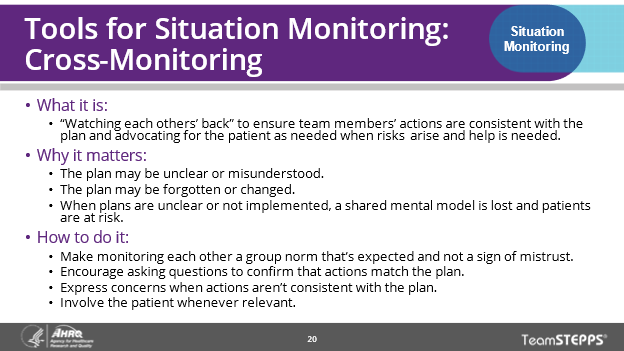
On Slide 20, “Tools for Situation Monitoring: Cross-Monitoring,” introduce cross-monitoring as another tool for situation monitoring and briefly note what it is, why it matters, and how to do it. You don’t need to address each bullet point on the slide; just encourage participants to consider the points as they watch the following video.
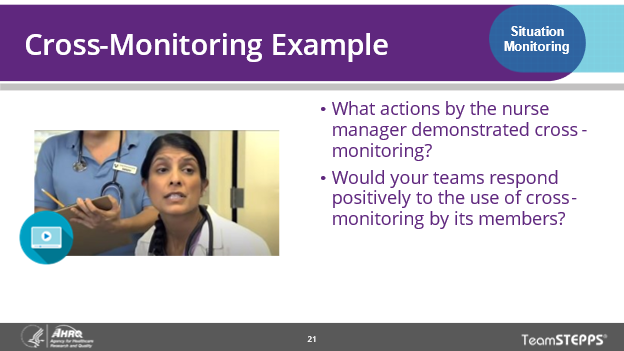
Play the video embedded in Slide 21, “Cross-Monitoring Example.” Then lead the group discussion to get responses to the questions. Once the discussion is complete, introduce the final tool.
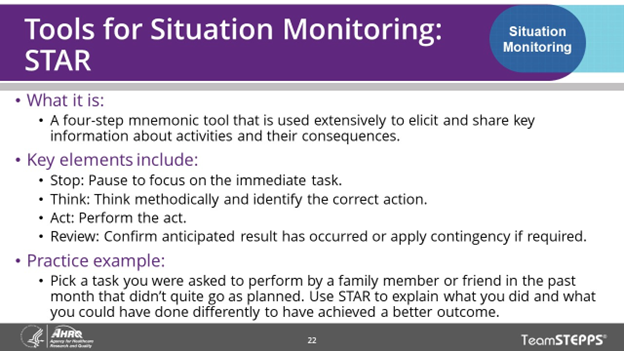
Use Slide 22, “Tools for Situation Monitoring: STAR,” to provide a short overview of STAR using an example from a clinical setting. Several are provided in section 2 in the Module 2 description. Depending on time and the participant group size, ask a volunteer to demonstrate STAR using the scenario on the slide. Alternatively, ask participants in each group to share their uses of STAR.
Unit Summary
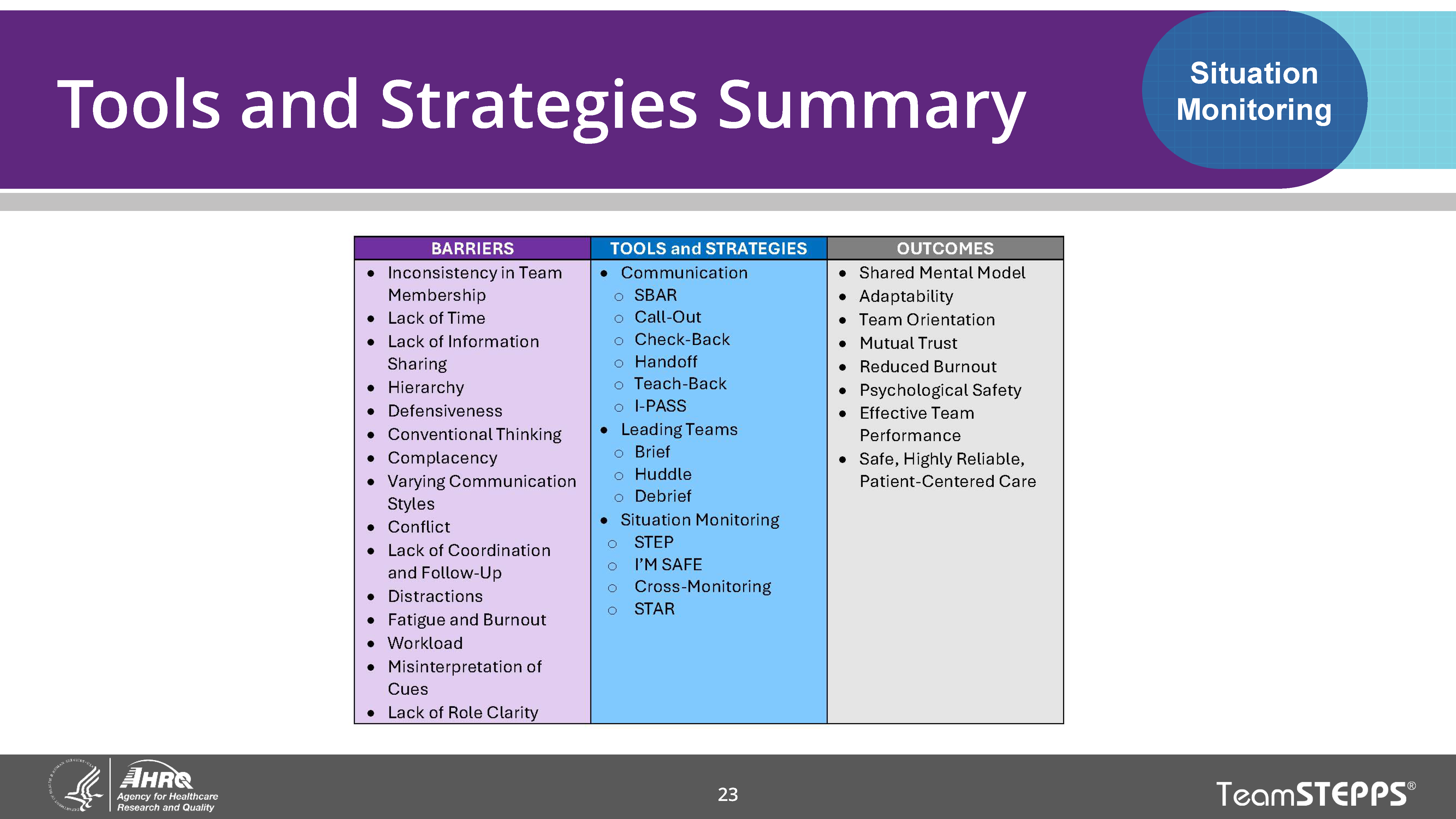
When displaying Slide 23, “Tools and Strategies Summary,” note that the participants have just learned four important new tools to go along with the communication and team leadership tools learned in Modules 1 and 2. All these tools help overcome the barriers and achieve the desired outcomes. STEP, I’M SAFE, cross-monitoring, and STAR can foster situation awareness and a shared mental model needed to work effectively as a team to provide the best possible patient care.
If you have time, ask the class which situation monitoring tool you’ve just discussed that they are the most eager to use. Encouraging participants to publicly identify a tool they intend to try will increase the likelihood that they begin to use it in their work.
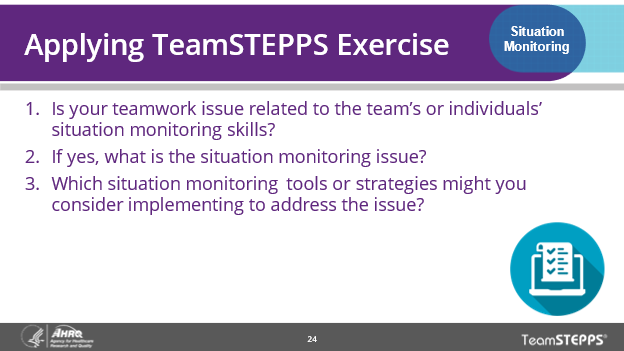
Slide 24, “Applying TeamSTEPPS Exercise,” can be used if you have teams representing two or more people from the same organization or unit attending your training and have introduced the Implementation Worksheet. If so, you can finish the discussion of situation monitoring by asking the groups to return to the Worksheet and answer the questions related to situation monitoring as they relate to the teamwork issue they are trying to address. Otherwise, this slide can be omitted.



